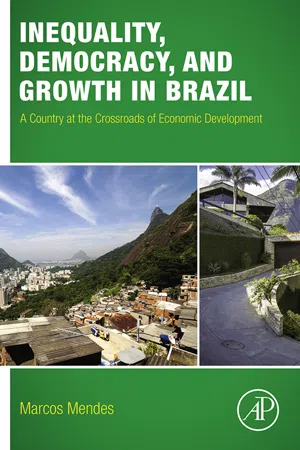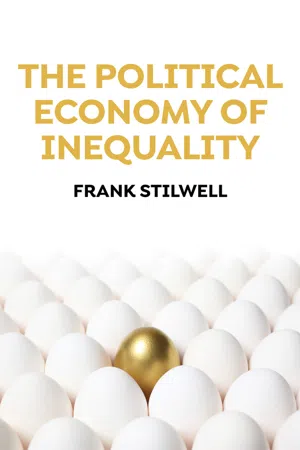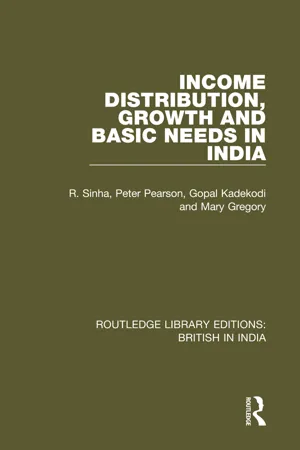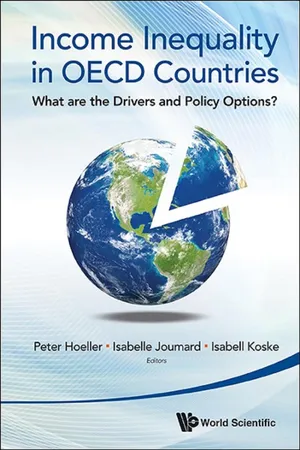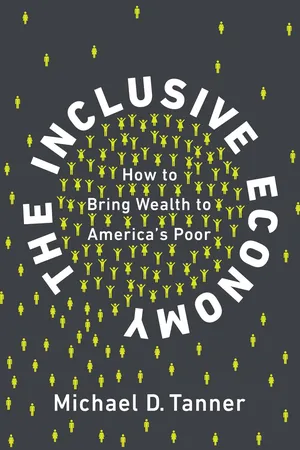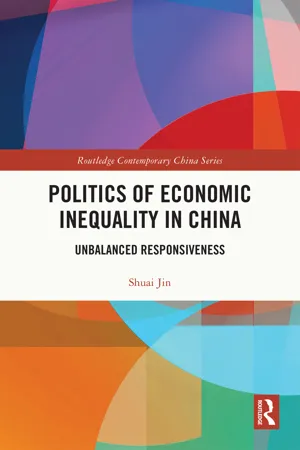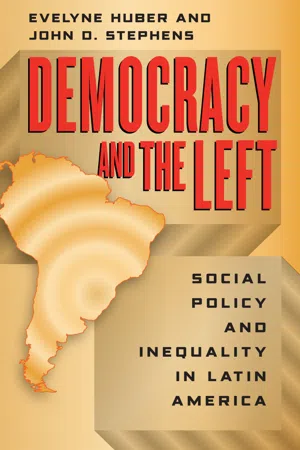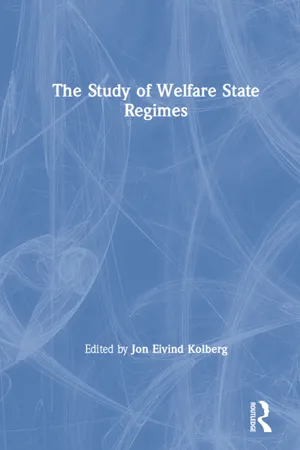Economics
Income Redistribution
Income redistribution refers to the transfer of income from some individuals or groups to others, typically through government policies and programs. The aim is to reduce income inequality by providing financial assistance to those with lower incomes and imposing taxes on those with higher incomes. This process is often a key focus of economic and social policy discussions.
Written by Perlego with AI-assistance
Related key terms
10 Key excerpts on "Income Redistribution"
- eBook - ePub
Inequality, Democracy, and Growth in Brazil
A Country at the Crossroads of Economic Development
- Marcos Mendes(Author)
- 2014(Publication Date)
- Academic Press(Publisher)
Chapter 4Redistribution to the Poor
Abstract
The co-existence of a high degree of inequality within a democratic political regime leads to the adoption of public policy directed toward the redistribution of income and poverty reduction. In a democracy, it is natural for the political class to meet the demands of the poor in exchange for a large number of votes. Redistributive policies are made by means of public expenditures for programs directed toward the poor, as well as economic regulation. Even while successful in reducing inequality and poverty, these policies can harm economic growth. They cause the increase of government expense, driving other facts that undermine economic growth: increased tax burden, reduction of public savings, increase in interest rates, and cuts to public investment in infrastructure.Keywords Inequality poverty redistributive policies cash transfers public education public health minimum wage social programs public expenditure tax burdenChapter Outline4.1Introduction1534.2What Does Economic Theory Have to Say?1544.3The Fiscal Impact of Income Transfer to the Poor1574.4Expansion of Public Education for the Poor and its Fiscal Impact1594.5Expansion of Public Health to the Poor and its Fiscal Impact1614.6Conclusions164References1654.1 Introduction
Hired housekeepers are common in Brazil. Young girls from poor families originally from rural areas, generally with little education, are employed by families to care for their cleaning, cooking, laundry, and, at times, children. Historically, this work has always been associated with people from the lower classes. In many cases, they work long days, live at their place of employment, have few days off, and are neither formally registered with Social Security nor have other legal worker rights. (According to ILO 2013 there are more than 7 million domestic workers in Brazil.) - eBook - ePub
- Thomas Piketty, Arthur Goldhammer, Arthur Goldhammer(Authors)
- 2015(Publication Date)
- Belknap Press(Publisher)
{FOUR}Instruments of RedistributionThe two previous chapters have tried to show how important it is to understand the socioeconomic causes of inequality in order to know what instruments of redistribution are most appropriate. In this chapter I will continue to analyze the most important of these tools in the light of contemporary experience. As I have done throughout, I will continue to distinguish between pure and efficient redistribution.Pure Redistribution
The primary tool for pure redistribution is fiscal redistribution, which makes it possible to correct inequality due to unequal initial endowments and market forces while preserving as much as possible of the allocative role of the price system. I will focus here on fiscal redistribution of labor income. In Chapter 2 , I analyzed some of the specific problems associated with the redistribution of capital income, which is less important than labor income.Average and Marginal Rates of Redistribution
To what extent do governments rely on fiscal redistribution today? In practice, modern fiscal redistribution depends on a variety of taxes (such as income tax, value-added tax, social charges), transfers (such as family allowances, unemployment insurance, guaranteed minimum income, and pensions), and expenses paid directly by the government (for health, education, and so on). An index often used to measure the extent of taxes and transfers in a given country is the total of all taxes as a percentage of GDP. For example, obligatory taxes amount to 30–35 percent of GDP in the United States and United Kingdom, 45–50 percent in Germany and France, and 60–70 percent in the Scandinavian countries. This is a poor measure, however, because it tells us nothing about how taxes, transfers, and expenditures are distributed. Furthermore, different accounting conventions in different countries make it difficult to compare these numbers. In Sweden and other Nordic countries, for example, pensions and other state-paid income is taxed like other income, and this increases the tax burden by nearly 10 percent of GDP in a totally artificial way. In France, this would be tantamount to financing a pension increase by increasing social charges on retirees, which obviously has no effect on actual redistribution. - eBook - ePub
- Frank Stilwell(Author)
- 2019(Publication Date)
- Polity(Publisher)
PoliciesPassage contains an image
10RedistributionTurning from the analysis of patterns, processes and problems to consideration of public policies raises big questions about what could or should be done. Could we have more egalitarian societies? If so, by what means? And who would effect the change? Looking to governments for that purpose is the normal first response. All governments tax and spend; and they commonly claim to be adjusting those taxes and expenditures to ameliorate inequalities. Critics of extreme inequality commonly call for more vigorous redistribution. Some go further, arguing that governments should not just be redistributing the existing ‘market’ incomes and wealth: they should also be trying to reduce the pre-tax inequalities.To provide a framework for considering these various aspects of the state in the economy, Figure 10.1 on the next page sets out the types of policy that currently operate in most countries, giving examples in each category. The focus of this chapter is on policies for redistribution that appear in the top row of the figure. These are primarily fiscal policies: comprising government taxes, transfer payments and other forms of government expenditure. Among the array of tax options are income tax (‘pay as you earn’), business tax (‘pay as you profit’), inheritance tax (‘pay as you go’), wealth tax and land tax. Among the different types of expenditure are the provision of social infrastructure and services.This chapter considers the policy instruments that governments could use for redistribution if they had the political will to act.The state and economic inequalityFigure 10.1Principles for taxation
The tax system is an obvious place to start when seeking to create more equality in the distribution of income and wealth. ‘Too little, too late’, some might say, because, by the time people have received their incomes and (in some cases) accumulated their wealth, the inequality already exists. ‘Well, better late than never’ is a reasonable response, because the tax system can make the post-tax distribution significantly less unequal than the pre-tax distribution. Because national governments always have tax policies of some sort, the key questions in practice are ‘How much redistribution?’ and ‘By what means?’ - R. Sinha, Peter Pearson, Gopal Kadekodi, Mary Gregory(Authors)
- 2017(Publication Date)
- Routledge(Publisher)
Two striking features seem to emerge from this description of a straightforward, once-for-all transfer of income from rich to poor. The first is the pervasiveness and complexity of the repercussions, involving all income classes in a sequence of income gains and losses as levels and patterns of both expenditures and incomes adjust. Perhaps most striking of all is the speed and completeness with which the income advantage given to the poor is wiped out by the structural forces within the system.Effective Redistribution of Income
It was inevitable that a once-for-all income transfer should bring only a temporary improvement in the income position of the poor and the level of employment. Of much greater significance, in terms of policy implications, is a redistribution of income where the target group is raised to, and then maintained at, a higher level of income. The objective in our second set of simulations is to explore the nature and implications of the redistribution required for this. Since, as the previous simulation showed, an income transfer from the rich to the poor is largely reversed almost immediately by the system itself, in the current exercise the income retained by the target group at the end of each round is augmented by whatever further transfer is necessary to bring them to a level of Rs 10 per capita above their pre-redistribution position. This process of replacing the amount eroded from the income transfer is continued until a new configuration of income levels is reached at which the incomes of all classes are constant, with the target group Rs 10 per head above its base level and the transfer being made at a constant rate in every round. In this new equilibrium, the income transfer will typically not be exactly equal to the Rs 10 per capita gained by the target group, because of the impact on their incomes of the spillovers brought about by the redistribution itself. Similarly, through spillovers the Income Redistribution will affect the incomes of all other groups, in addition to those directly involved in the transfer. The changes in the level and distribution of income will in turn affect the level of employment. The results of this exercise are summarised in Tables 4.4 and 4.5- eBook - ePub
Concepts in Social Administration
A framework for analysis
- Anthony Forder(Author)
- 2022(Publication Date)
- Routledge(Publisher)
State redistribution between individuals is generally regarded as being aimed at a transfer of income from rich to poor, or from higher to lower social classes. This is not necessarily the case.Education, which takes about one quarter of the resources devoted to state social services, is strongly biased towards benefiting an élite group which is largely recruited from better-off families. Vaizey,17 for example, estimated that in 1951 the annual educational subsidy per child in middle income groups was two-thirds greater than in lower income groups. A grammar school child throughout his secondary school career gained double the resources of a secondary modern pupil.To a lesser extent the same is true of assistance to owner-occupiers in the housing market.Much of the redistribution that takes place through taxation and the social services is a transfer between those with different needs but in the same income group. Examples are provided by income tax allowances for children, graduated benefits in social security, and superannuation schemes provided by employers and supported by tax allowances.Webb and Sieve18 analysing the processes of individual redistribution call transfers between different income groups ‘vertical redistribution’. If this takes place from richer to poorer people they call it ‘positive’; if in the opposite direction it is ‘negative’. Transfers between those with the same income but different needs they call ‘horizontal redistribution’. In all these forms of redistribution, the transfer of income between particular income groups is an essential element of the provision. Webb and Sieve call this ‘Income Redistribution’ as opposed to ‘contingency redistribution’ in which policies are designed to meet specific needs of people who may be in any income group. The National Health Service is an example of contingency redistribution. They point out that contingency redistribution is the only form of redistribution to arise from the provision of social services per se.19In the redistribution of resources between individuals two broad alternative systems may be used, ‘universal’ or ‘selective’. In a universal system services and benefits are provided to all those in need regardless of their wealth or income from other sources. Examples are the British health, education and national insurance systems. In a selective system services are provided to those in need only if their resources are insufficient to enable them to purchase the services through the economic market and monetary benefits are only provided to those with incomes below a minimum standard. Examples are free school meals and the supplementary benefits system. - eBook - ePub
Income Inequality In Oecd Countries: What Are The Drivers And Policy Options?
What are the Drivers and Policy Options?
- Peter Hoeller, Isabelle Joumard, Isabell Koske(Authors)
- 2013(Publication Date)
- WSPC(Publisher)
4. Income Redistribution VIA TAXES AND TRANSFERSIsabelle Joumard, Mauro Pisu and Debbie BlochIntroduction and Summary
The recent financial and fiscal crisis has pushed governments to contain public spending, including cash transfers, while both fiscal consolidation and equity considerations have led some government to raise taxes, in particular on top incomes. Against this background, this chapter assesses different tax and transfer policy approaches and their effectiveness in reducing income inequality.The second section of this chapter reviews the redistributive impact of taxes and transfers. The third section summarizes tax and transfers policy indicators in country profiles and provides an illustration on how these profiles can be used to identify reform options for two OECD countries (Australia and Germany). It also provides a typology of tax and transfer systems, identifying five groups of countries sharing broadly similar features.Main Findings
The redistributive impact of taxes and transfers• Taxes and transfers have a significant redistributive impact. Inequality in income after taxes and transfers, as measured by the Gini index, was about 25% lower than for income before taxes and transfers on average in the OECD area in the late 2000s. For the same period, poverty measured after taxes and transfers was 55% lower than before taxes and transfers for the OECD average.• Countries with a more unequal distribution of market income tend to redistribute more.• Cash transfers reduce income dispersion more than taxes in most OECD countries. On average, three quarters of the reduction in inequality as between market and disposable income are due to transfers, the rest to taxes.• The redistributive impact of cash transfers varies widely across countries. Countries with a similar dispersion of household market income (HMI) opt for distinct redistributive strategies. In some, cash transfers account for a large share of household disposable income (HDI), redistributing income mainly over the lifecycle rather than across individuals — old-age pensions often fall into this category — and their progressivity is low in many countries. Other countries with smaller cash transfers tend to rely more on targeted benefits. And some make little use of cash transfers to reduce income inequality. - eBook - ePub
The Inclusive Economy
How to Bring Wealth to America's Poor
- Michael D. Tanner(Author)
- 2018(Publication Date)
- Cato Institute(Publisher)
CHAPTER FOUR: THE LIMITS OF REDISTRIBUTIONInsanity is doing the same thing over and over and expecting different results.—UnknownEfforts to fight poverty can best described as throwing money at the problem. Contrary to public perception, the American welfare system is far from stingy. Indeed, we already do a great deal of redistribution of wealth.To start with, U.S. taxes are progressive, significantly so. The top 1 percent of tax filers earned 20.6 percent of U.S. income, but paid 39.5 percent of federal income taxes in 2014.1 The inclusion of other taxes (payroll, sales, property, and so on) reduces this disparity but does not eliminate it: a report from the Congressional Budget Office (CBO) estimates that the top 1 percent paid 25.4 percent of all federal taxes in 2013, compared with the 15 percent of pre-tax income that they earn.2 The wealthy pay a disproportionate amount of taxes.At the same time, lower-income earners benefit disproportionately from a variety of wealth transfer programs. The federal government alone currently funds more than 100 anti-poverty programs, dozens of which provide either cash or in-kind benefits directly to individuals. Federal spending on those programs approached $700 billion in 2015, and state and local governments added another $300 billion.3Figure 4.1 Redistribution by Income Quintile and Top 1 Percent, 2012Source: Gerald Prante and Scott A. Hodge, “The Distribution of Tax and Spending Policies in the United States,” The Tax Foundation, November 8, 2013, http://taxfoundation.org/article/distribution-tax-and-spending-policies-united-states .Figure 4.1 shows the amount of redistribution taking place within the current tax and transfer system. In 2012, individuals in the bottom quintile (that is, the bottom 20 percent) of incomes (families with less than $17,104 in market earnings) received $27,171 on average in net benefits through all levels of government, while on average those in the top quintile (families with market incomes above $119,695) pay $87,076 more than they receive. The top 1 percent paid some $812,000 more.4 - eBook - ePub
Politics of Economic Inequality in China
Unbalanced Responsiveness
- Shuai Jin(Author)
- 2023(Publication Date)
- Routledge(Publisher)
Jæger 2006 ). However, preference for redistribution is not the same as support for state intervention because state intervention is not necessarily redistributive. State provision of welfare benefits cannot be assumed to redistribute income or wealth in a progressive way, as we have seen in the case of China’s welfare system, where heavy state intervention results in the regressive redistribution of income and resources.The second aspect of welfare support is the support for the welfare state as it currently exists. Researchers have examined citizens’ support for certain welfare programs or support for increasing government spending on these programs to indicate a preference for redistribution (Blekesaune and Quadagno 2003 ; Rehm, Hacker, and Schlesinger 2012 ). However, preference for redistribution, again, is different from support for welfare programs because, again, welfare programs are not necessarily redistributive. Governments can set up regressive welfare programs that heavily benefit the advantaged and only give petty favors to the disadvantaged and vulnerable.The preference for redistribution, as discussed in the theory of unbalanced responsiveness, is a clear demand for redistribution in a progressive manner to reduce the level of inequality and deliver the egalitarian promises of propaganda. Therefore, in this chapter, I examine the preferences for redistribution using instruments that clearly state that the aims of state intervention are to reduce poverty or inequality.What shapes preferences for redistribution to lower economic inequality? An abundant amount of literature has studied this question, examining both system-level factors and individual-level factors (Alesina and Glaeser 2004 ; Jæger 2006 ; Kenworthy and McCall 2008 ; Svallfors 2012 - eBook - ePub
Democracy and the Left
Social Policy and Inequality in Latin America
- Evelyne Huber, John D. Stephens(Authors)
- 2012(Publication Date)
- University of Chicago Press(Publisher)
In their analysis of microdata on household income, ECLAC (2005) found that in three of eleven countries studied (one of them Uruguay; see table 3.1), social security income was actually more unequally distributed than net household income. Without information on the financing of the system, however, even for these cases one cannot infer that the system necessarily redistributes income upward. By the very structure of the system, only formal-sector workers make contributions to the system, which appears to reduce the distributively perverse aspects of the system precisely because only the beneficiaries make contributions to it. One needs to keep in mind, however, that the system, and particularly the generous benefits of high occupational groups, is subsidized by the state and thus by general taxation, and therefore, to the extent that informal-sector workers pay indirect taxes, they subsidize the benefits paid to formal-sector workers. Thus, one is on safe grounds in saying that at best, contributory social insurance will effect little redistribution and, in any case, cannot be expected to affect the high levels of redistribution that these systems do in some of the advanced capitalist democracies, most notably the Nordic countries. The Paradox of Redistribution Korpi and Palme (1998) have identified what they term the “paradox of redistribution” among postindustrial welfare states, that is, the welfare states that most target social benefits at the poor redistribute income the least. All welfare states in advanced industrial democracies redistribute income, though they do so to greatly varying degrees. Table 3.3 presents our own calculations, based on LIS data, of Income Redistribution among the working-age population, in order to counter the criticism that welfare states only redistribute income across generations. The first three columns document reduction in inequality as a result of taxes and transfers; the next three columns do the same for poverty reduction - eBook - ePub
- Jon Eivind Kolberg(Author)
- 2019(Publication Date)
- Routledge(Publisher)
In specifications A, B, and C, economic inequalities between families are analyzed, but the number of people affected by these inequalities is not considered. This is not reasonable. In the welfare equation of the society, which includes income distribution, each individual should hold equal weight regardless of the size of the family to which he or she happens to belong. Ideally, we should therefore take the individual, and not the family, as the unit of analysis. The economic welfare of an individual depends on the total income of the family to which he or she belongs, but only individuals are ultimately the consumers of welfare. The specification of type F is recommended, as is now widely accepted in the methodological literature (van Ginneken 1979, 368; Cowell 1984, 359; Uusitalo 1985, 163–76; O’Higgins et al. 1985; Kakwani 1986), and as was first used empirically by Gustafsson (1984).The analysis of Income Redistribution
The standard method for the empirical analysis of the redistributive impact of transfers and taxes is the so-called fiscal incidence method in which the distributions of the various income concepts referring to the process of income formation are compared (see Table 3.2 ). The difference between the distributions before and after some policy intervention is taken as a measure of the redistributive impact of that particular intervention. For example, the redistributive impact of cash transfers is found by comparing the distribution of gross income to that of factor income, and the redistributive impact of taxes is found by comparing the distributions of disposable and gross income.Table 3.2The Process of Income Formation in Standard Method Redistribution Analysiswages and salaries + income from self-employment + income from property = factor income + cash transfers = gross income – taxes = disposable income – indirect taxes + benefits in kind = final income The major limitation of this approach is that it catches only direct effects; indirect effects are ignored. Implicitly, the standard method assumes that the factor income distribution is the distribution of income before the welfare state. This is, of course, a considerable simplification. Taxation, for example, may have incentive effects that could influence the distribution of factor income; social security benefits may encourage some people to work less than they would have done in the absence of the benefit, and thereby influence the distribution of factor income. By restricting the study to direct effects, the degree of redistribution is generally exaggerated. On the other hand, the estimated redistribution is real in the sense that it reflects existing flows of income and services, and the resulting income distributions.
Index pages curate the most relevant extracts from our library of academic textbooks. They’ve been created using an in-house natural language model (NLM), each adding context and meaning to key research topics.
